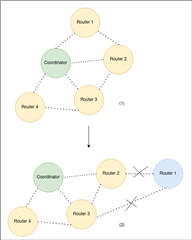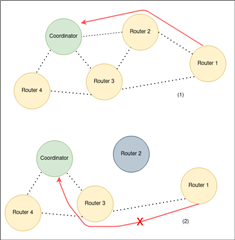Hi guys,
So i have some Nordic DK board including some dongles, NRF52840 DK, NRF52833 DK running with Zigbee and thread SKD 4.1.0 and make a mesh out of them. But I have this problem with mesh topology in Zigbee relating to route discovery. I did 2 experiments
1.The first experiment is set up like this figure

So I have a mesh of devices including some zigbee routers and 1 coordinator like in (1). I tried to move the router 1 on top away from the coordinator so that it is out of range and would send a message to the coordinator through a hop in the middle like in the (2) . From what i learn in the zigbee spec, the router will try to fix and create a new route if the destination is unreachable. I use a sniffer to monitor the network but i did not see any route request sent even after 3-4 minutes. Then, I reset the device but still nothing happened. So how can I make a out of range router to rebuild a route to the coordinator. Is it suppose to make a new route when the destination address is not in the routing table.
2.The second experiment i did is that I create a mesh with 1 coordinator and 4 routers like the figure below

So this time, i managed to make router 1 to join through router 2( which is near router 3) and send message to coordinator like in (1). But the problem is that, when i turn off router 2. In theory Router 1 should re route to path (2). But it did not, when it sent out the message, it kept sending to the addr 0x0000 and not start to send any route request. This time i also waited for 4 minutes and reset every device in the network. But still nothing happened.
For the firmware inside, I ran Cli zigbee example coordinator and ran a custom firmware from light bulb example on all of the routers. I will attach the firmare at the end so that you can take a look at it with all the SDK config and makefile
Thank you for any help, the code for router is included below
Mateus



